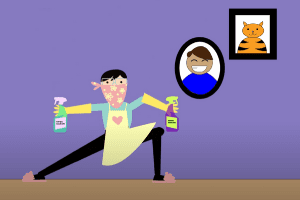Art students use animation to teach virus safety

Students in Professor Heather Freeman’s animation class have created short animated videos that encourage personal hygiene to prevent the spread of COVID-19. The students’ advice was drawn directly from the Centers for Disease Control and Prevention (CDC) and addresses topics such as proper hand washing, maintaining six feet of distance, disinfecting surfaces and caring for someone who is sick.
The course, ARTM 3103 Animation, focuses on the basic principles of animation found in nearly all moving imagery, from 3-D character animation to interface animations on cell phones, said Freeman. When classes moved online mid-semester, she created online video tutorials to teach students character and text animation.
Around that same time, the United Nations called upon artists to help translate “critical public health messages into work that will engage and inform people across different cultures, languages, communities and platforms.”
“I realized this was a great opportunity to use animated forms to convey useful and timely information,” Freeman said.
For their projects, students selected blocks of text from the CDC website. They could then focus on “character animation, with minimally animated text, or dynamic text animation, with minimally animated graphic elements,” said Freeman. Students who lacked home access to the technology required for the animation projects created informational posters instead. The final products bring color, energy and an element of fun to rather mundane messages.
“Although this was not an ideal situation for teaching something as nuanced and complex as animation, especially for students with limited tech resources, I am incredibly proud of what they accomplished,” Freeman said.
Freeman, who grew up in a family of scientists, has recently devoted her own creative skills to addressing critical needs resulting from the coronavirus outbreak. Since mid-March, she has been a member of the Charlotte MEDi team, using 3-D printing to make face shields for medical professionals. So far, the group, which also includes Associate Professor of Art Tom Schmidt and Storrs Fabrication Lab staff Alex Cabral and Robby Sachs, has made more than 106,000 shields.